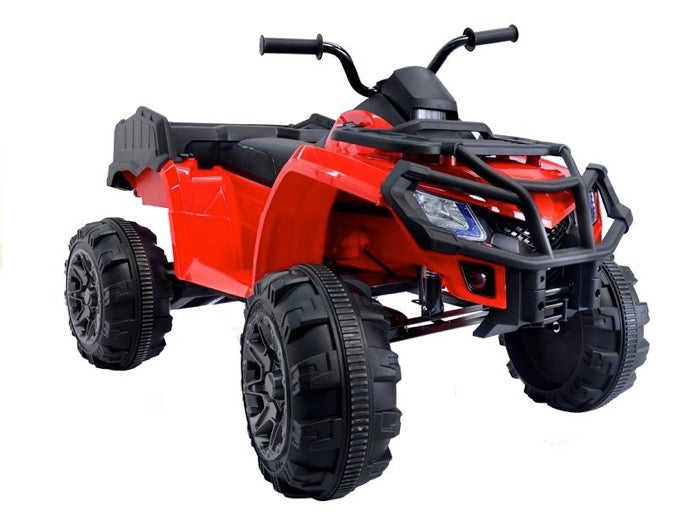Taking interests and preferences into account:
Your child's individual preferences and interests are not only crucial for their personal development, but also for choosing the perfect children's vehicle. In this section, we'll delve deeper into the importance of these personal aspects and discuss how licensed models and themed designs can not only increase driving pleasure, but also inspire your little driver's enthusiasm and imagination.
Licensed models for authentic enthusiasm:
Licensed children's vehicles inspired by well-known car brands such as Ferrari, BMW or Maserati offer an authentic and realistic driving experience. These models are not only detailed replicas, but also bear the official logos and designs of the respective brands. For little car lovers, this creates a unique connection to the vehicles they see on the roads. The opportunity to drive in a licensed children's vehicle allows children to experience their favorite car brands up close and deepen their enthusiasm for cars.
Theme-specific designs for creative gaming moments:
Themed designs go beyond the world of real cars and offer a wide range of creative possibilities. From fire engines to princess carriages to dinosaur vehicles, there are a variety of themed options to suit your child's interests and preferences. These special designs open up a world of creative play where children can develop their imagination and take on different roles. A themed children's vehicle becomes not just a vehicle, but a living part of the child's imagination.
Integration of favorite colors and patterns:
The selection of children's vehicles can also be personalized by incorporating favorite colors and patterns. Whether vibrant red, bright blue or cheerful yellow - the option to choose the vehicle in your child's favorite colors not only increases the visual appeal, but also promotes identification with their own toy. The ability to add individual patterns or stickers gives the children's vehicle a personal touch.
Sporty designs for active children:
For children who are passionate about certain sports or activities, sporty designs can be an ideal choice. From racing stripes to football motifs – the variety of sporty children's vehicles makes it possible to integrate your child's hobbies and preferences into the play experience. Such designs not only promote identification, but also the joy of movement and active play.
Development of interests through play:
Choosing a children's vehicle based on your child's interests goes beyond just owning a toy. It creates an environment in which children can not only pursue their current interests, but also develop and discover their preferences. By integrating interests into the game, the children's vehicle not only promotes fun, but also the continuous development of your child's personality.
Taking interests and preferences into account is therefore not only a crucial factor when choosing a children's vehicle, but also a key to creating a playful environment that supports children's enthusiasm for discovery and learning. By tailoring the vehicle to your child's individual preferences, you create a personalized play world that not only provides hours of fun, but also promotes emotional and creative development.
-> To the chapter overview | to the top
Parental supervision and guidance:
Parental supervision and guidance when playing with children's vehicles is crucial to not only ensure safety, but also to encourage the development of a healthy level of independence and responsibility. In this section, we will discuss in depth how parents can shape their role as companions and guides to ensure a safe, educational and at the same time entertaining play experience.
Active support while playing:
Parental supervision should not be limited to monitoring, but should include active support. Parents can participate in play by interacting with their children, encouraging them and having adventures together. This not only strengthens the bond between parent and child, but also allows parents to better understand their child's abilities and needs.
Clear instructions and safety rules:
Clear instructions and safety rules are essential parts of parental guidance. Before the child plays with the children's vehicle, parents should establish basic rules for safe use. This may include wearing protective equipment, choosing a safe play area, and following traffic laws (if playing outdoors). Clear instructions provide children with clear guidelines that help them develop a sense of responsibility.
Gradual increase in independence:
Parental guidance should aim to gradually promote the child's independence. Closer supervision may be necessary initially, especially if the child is just starting to use the vehicle. However, with time and increasing trust, parents can gradually expand the child's freedom. This allows the child to make their own decisions and develop a sense of control over their actions.
Communication and feedback:
Open communication between parents and children is crucial. Parents should encourage their children to ask questions and share their experiences. At the same time, it is important to provide constructive feedback to reinforce positive behavior and address any safety concerns. Communication creates a foundation of trust and promotes a supportive environment in which children can learn.
Flexibility and adaptation to individual needs:
Every child is unique, and parental guidance should be flexible to individual needs. Some children develop a sense of responsibility more quickly, while others need more time. Parents should adapt their approach to their child's needs and temperament to ensure effective and supportive guidance.
Parental supervision and guidance are not only a means of ensuring safety, but also an opportunity to promote the child's personal development. Through a balanced mix of active participation, clear instructions, gradual independence, open communication and individual adaptation, parents can play a meaningful role in accompanying their children as they explore the world of children's vehicles.
-> To the chapter overview | to the top
Care and maintenance of children's vehicles:
The care and maintenance of children's vehicles is not only a parent's responsibility, but also crucial to the safety and longevity of the toy. This section provides detailed tips and instructions on how parents can ensure that the children's vehicle remains in optimal condition.
Regular cleaning and inspection:
Regular cleaning is not only aesthetically pleasing, but also crucial for the functionality of the children's vehicle. Dirt, dust and other debris can affect the mechanisms. Parents should inspect the vehicle after each use and ensure that there are no foreign objects obstructing the wheels, pedals or other moving parts.
Checking the wheels and tires:
The wheels and tires are largely responsible for driving stability and safety. Parents should regularly check tire pressure and ensure wheels are properly aligned. Loose or damaged wheels should be repaired or replaced immediately to avoid accidents.
Lubrication of moving parts:
The moving parts of the children's vehicle, such as pedals, steering or axles, should be well lubricated to ensure smooth movements. Parents should follow the manufacturer's recommended lubrication intervals and ensure that only appropriate lubricants are used.
Battery care for electric vehicles:
The battery is a central element in electric children's vehicles. Parents should regularly check the battery to ensure it is charging properly. Charging times should be in accordance with the manufacturer's recommendations and immediate action should be taken if there are any signs of loss of performance or unusual battery behavior.
Checking the electrical components:
Regular inspection of the electrical components is essential for electric children's vehicles. Check the operation of lights, horns and other electrical features to ensure they are working properly. Defective or damaged electrical parts should be repaired or replaced immediately.
Storage and protection from weather influences:
The type of storage has a significant impact on the lifespan of the children's vehicle. If the vehicle is stored outdoors, it should be protected from the elements. Covers or special storage options can help protect the vehicle from rain, sun and other environmental influences.
Follow the manufacturer's instructions:
Care and maintenance should always be carried out in accordance with the manufacturer's instructions. Each manufacturer provides specific recommendations for the care of their product, which should be strictly followed to maintain the warranty and ensure safe use.
Repairs by qualified personnel:
In the event of major damage or repairs, parents should ensure that these are carried out by qualified specialist personnel. Attempting repairs yourself without the necessary know-how can lead to further damage and impair the safety of the children's vehicle.
The care and maintenance of children's vehicles is crucial to ensure long-term, safe use. By carrying out regular inspections and maintenance and following recommended care tips, parents not only contribute to the safety of their child, but also maximize the life of the child's vehicle.
-> To the chapter overview | to the top

























